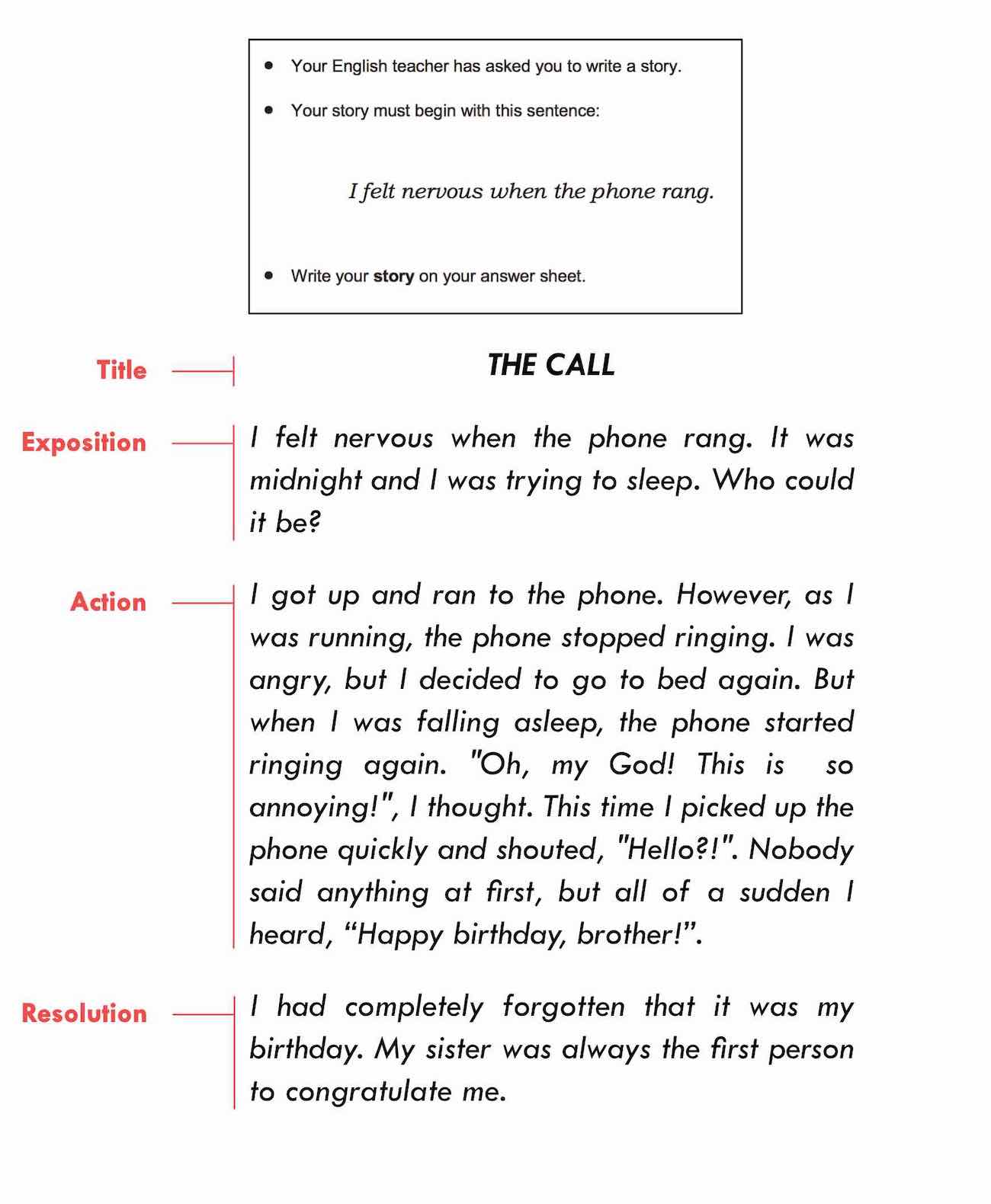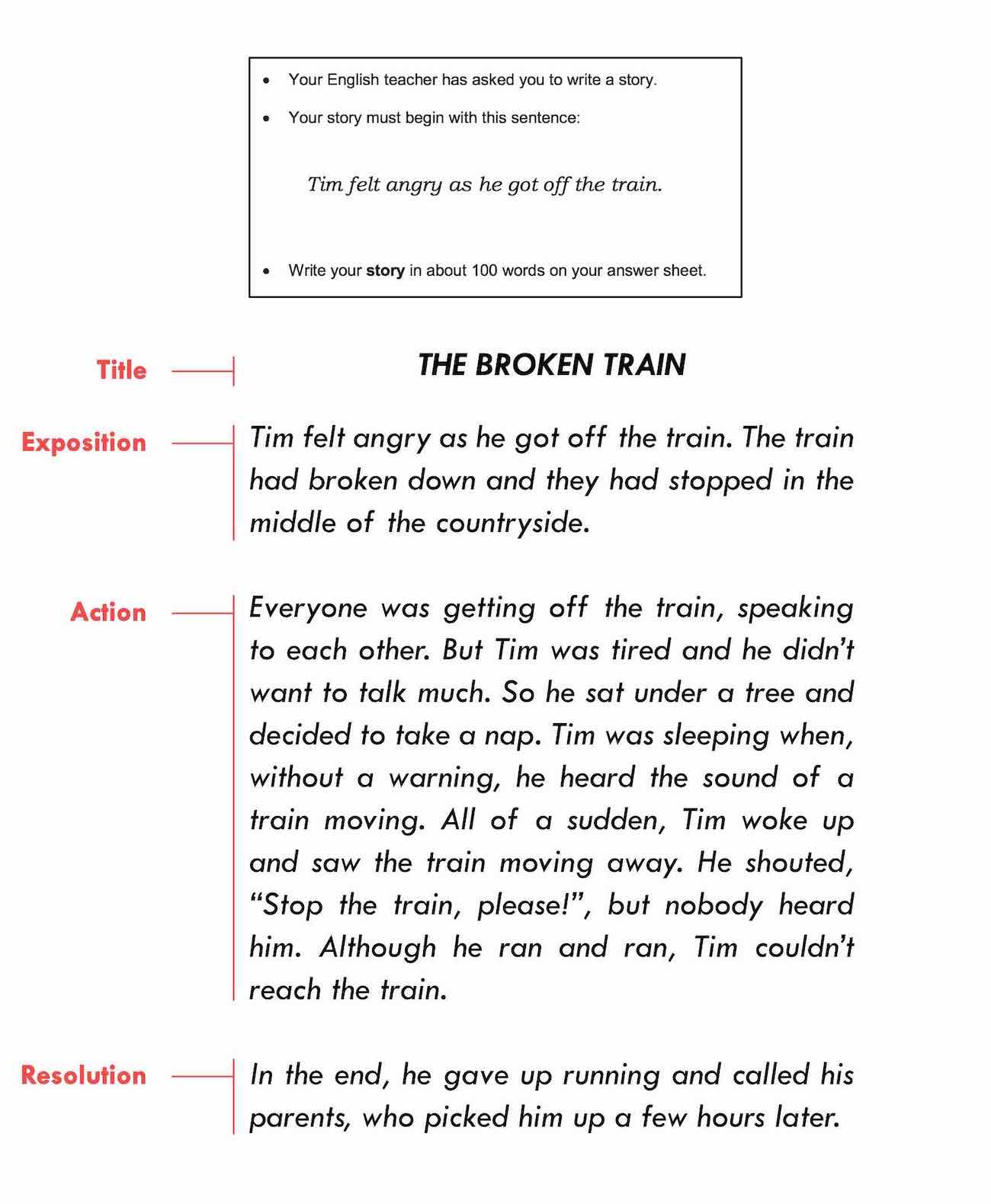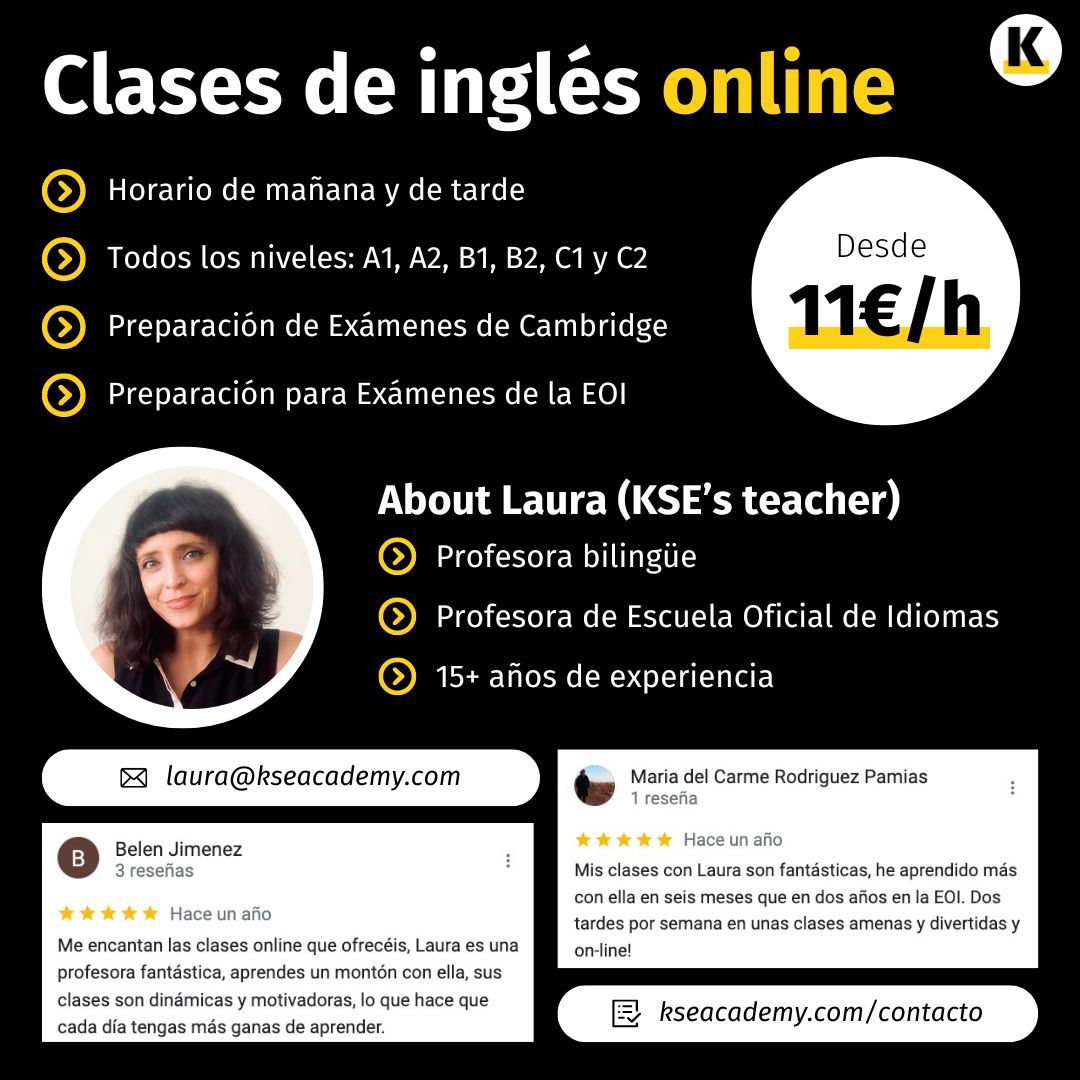The B1 Preliminary (PET) exam has suffered some changes that become effective in January 2020. Among the parts most affected are Speaking and Writing. However, the B1 Writing part we will be reviewing today hasn’t suffered any changes, except for now belonging in Part 2 instead of Part 3, as there is no Part 3 in the new exam. So today I will teach you how to write a story at B1 level for your B1 Preliminary (PET) exam. We already saw how to write an email, so it’s now time to focus writing a story for PET.
How to write a story for B1 Preliminary
Now, before seeing a sample task, we will focus on what is a story, so we can understand this kind of task better and have a more accurate expectation of what is expected of us in this part of the Writing for PET.
What is a story?
According to the Lexico.com (before Oxford Dictionaries), a story is «an account of imaginary or real people and events told for entertainment«. For this reason, precisely, you have plenty more freedom to write, as you can make up most of the story. But just like it happens with every other type of writing, a story must follow a particular structure which makes sense to the reader. So let’s move on to the different parts of a story.
Parts of a Story
A story can roughly be divided into the following parts:
- Title: The title should either summarise the whole story (without spoilers!) or have something to do with the main theme.
- Exposition: This is the beginning of the story, where the characters and setting are established. It serves as the introduction to the next part, the action, and the so-called conflict of our story.
- Action: In this part, the characters deal with conflict and do things to solve it.
- Resolution: This is where the conflict is resolved and the story concludes with an ending, normally without any loose ends.
Now that we know the different parts of a story, we should see an example.
Sample Story for B1 Writing
Let’s take a look at the following example of a Preliminary (PET) Writing Part 2 task, where we can see an answer to the sample task we saw above:

In the example above you can see the different parts of a story very well defined. Just like with emails or letters, your story should be visually appealing. For this reason I recommend the following:
- Write your title in capital letters.
- Leave a clear space between paragraphs.
Expressions to use in your story
In this section, we are going to focus on different expressions you can use in the different parts of a story. While the vocabulary used in the story will vary completely, depending on the topic, there is a set of expressions which you can make use of quite frequently if you memorise them beforehand. Let’s take a look:
How to begin a story
When you start a story, if the first sentence isn’t given to you, you can use phrases like these:
- It all began…
- When I first…
- At the beginning…
- It was a hot/cold summer/winter day.
Just to be clear, these are only some simple examples which you can use, as there is no right or wrong way to start a story. That’s the beauty of it!
Time phrases
One of the great differences between writing a letter, essay, article and so on, and writing a story is the need to pay careful attention to the time over which the story develops. In order to define the order of the events in the story, we must use time expressions or time phrases. So let’s see a few:
- Then
- After that
- Not long aftewards
- As soon as
- While
- Meanwhile
- As
- Some time later
- A little later
- ____ minutes later
- a moment later
- Later (that morning/afternoon/day/night…)
- Just then
It is essential to use these expressions properly. Otherwise, it won’t be clear exactly how the story develops.
Creating suspense
When writing a story, the aim is not to inform or to convey information; the real purpose is to entertain the reader, just like when you read a novel you expect to be entertained. For this reason, a story, even a story for Preliminary (PET) Writing Part 3 should aim to do so: entertain. And a cool way to entertain is to create suspense, which we can do by using some of the following expressions:
- Suddenly
- All of a sudden
- Without warning
- Just at that moment
- Unexpectedly
- Out of the blue
- Out of nowhere
- Right away
- Straight away
Direct speech
In every story there are characters and they usually interact with each other, so it is always good if you know how to use direct speech, that is, reproduce the words the characters actually say or think. The tricky bit about this is the punctuation and the verbs to choose, because it’s good to use some verbs other than «say». Let’s take a look at some examples:
- «I’m coming with you,» she said.
- She said, «I’m coming with you.»
- «Do you like it?» he asked.
- «Don’t do it!» he screamed.
Pay close attention at where the comma (,) or other punctuation marks go (?, !). Also, don’t forget to use inverted commas («…») to enclose the direct speech. In British English we normally use single inverted commas (‘…’), but it’s not important so choose the one that suits you best.
Finishing your story
This paragraph, the resolution, should be separated from the rest, and it’s a good idea to start it with one of the following expressions:
- In the end
- Finally
- When it was all over
- Eventually
- After everything that happened
- Luckily
Again, these are just a few examples. There’s no right or wrong way to conclude a story, as long as it makes sense with the rest of the piece of writing.
Verb tenses
One of the reasons why stories are particularly challenging for B1 students is that they tend to take place in the past, which makes it necessary to use a range of past tenses approriately. The main three past tenses you should really try to use are the following:
- Past simple (-ed/irregular form)
- Past continuous
- Past perfect
If you take a look at the example of Writing Part 3 above, you’ll see how I used these tenses in combination, when possible:
- Past simple and continuous:
It was midnight and I was trying to sleep.
- Past perfect and simple:
I had completely forgotten it was my birthday.
- Past simple:
This time I picked up the phone quickly and shouted, «Hello?!».
So that’s how you should try to tell your story. Please avoid a simple succession of past simple tenses alone, like:
I woke up and got out of bed. Then I went to the kitchen and made some coffee.
It’s not wrong, but it’s just not good enough for a story.
Another example story for B1 Writing Part 2
Now that we know what expressions we should be using when writing a story and how to combine the different tenses, let’s take another look at another task and a sample answer:

In the story above you can see different things:
- Well-defined structure: 3 clear paragraphs.
- A variety of past tenses: past simple (was tired, didn’t want, etc.), past continuous (was getting off, was sleeping, etc.) and past perfect (had broken, had stopped, etc.).
- Time expressions: in the end, when, a few hours later.
- Suspense elements: all of a sudden, without a warning.
Top 5 Tips for Writing a Story for PET Writing
- Learn, memorise and use some of these expressions. Make sure you already know a set of expressions to use in your next story. This will not only avoid you making mistakes, but also it will make your story so much better! It will give you points to use those expressions.
- Write a well-structured and visually-appealing story. One of the things Cambridge English examiners pay attention to is the organisation of your piece writing, so make sure not to write an incoherent story. Also, remember that punctuation matters, so be sure to separate your sentences with stops and commas and don’t write sentences which are too long.
- Brainstorm before you write. Before starting to write your story, brainstorm a couple of things and write down some ideas. This can include vocabulary related to the topic, connectors, time phrases, etc. Also, decide before writing how the story is going to end.
- Revise, edit and improve. Don’t write all at once and then move on. Once you have finished your story go over it. Look for possible mistakes. Look for ways to improve it, maybe adding adjectives here and there. You can save many points by simply reviewing what you’ve written.
- Experiment at home, be conservative in the exam. Homework is the best chance to be creative and experiment with stories. So make sure you try your hardest to keep improving when you write at home. On the other hand, when you’re doing an exam, don’t risk trying out new words or expressions, as you may be making a terrible mistake. So be safe in your exam and stick to what you already know works.
If you found this post useful, don’t forget to comment and share. You can also follow KSE Academy on Facebook, Twitter & YouTube.
Oh, and don’t forget to keep smiling! 🙂

50 comentarios en “How to Write a Story for B1 Preliminary (PET) Writing”
Muy claro, extenso y útil.
Gracias, Yolanda. Un saludo!
Excelente información, muchas gracias
Thank you! 🙂
Very useful thanks so much
Thank you, Francisco!
Great work,thank you!!
Thanks a lot for your comment. Take care! 🙂
Thanks Luis,
This article is very usefull and complete.
I’ll Try to do everythings you said.
I hope to do a good story.
Mary
Thank you, Mary. Take care and good luck! 🙂
Thanks Luis for your time, I really appreciate you teaching I will try to take your avise.
Thank you for your comment. I’m glad this site has helped you a little. Good luck!
Hola muchas gracias por el articulo, mi profesora me lo recomendó para realiar un Story de 120 palabras, me sirvió de mucho. Gracias !!!
Muchas gracias a ti y a tu profesora por leeros el artículo. Me alegro que os sea de utilidad. Un saludo!
Great help!!!!!
So useful to explain to the students.
Thanks a lot!
Thank you very much for your comment. 🙂
Gracias!
Hola, muy buen material para aprender, mi profe me pasó el articulo para que lo lea, Muchas gracias
¡Muchas gracias por tu comentario! 🙂
buen contenido me sirvio para estudiar
Thank you very much for sharing your work!
buen material
Perfect! Very clear and helpful. Thanks for sharing.
Great tips! Thanx Luis! Im def sharing this article with my students.
Thanks! Glad you liked it. Hope your students find it useful as well. 🙂
Me pareció muy interesante esta historia que me enseñara en un futuro muchas cosas.
Valeria Palacios
Thanks Luis! It´s been very useful for teaching my students.
That’s awesome! Thanks for letting me know! 🙂
Excellent material thanks becauuse we can use it in our classes. I really appreciate your help.
Thank you, Sandra! 🙂
bonjour, merci beaucoup je l’ai trouvé très utile
Many thanks this lesson plan is really good!
Thank you for your comment, Roberta!
Thanks you! Very useful and complete.
Thank you! 🙂
Thank you very much for explaining so clearly how to write a good story.
Thank you, Flavia. 🙂
thanks luis!!!!
You’re welcome, Pepita. 🙂
Good work, I will improve my writting skills now.
thank you
Thank you for your comment, Juan. Good luck!
Hello,
I am Charles III, King of England, and I congratulate you for helping the people out there with their PET exam. This is great, thank you so much.
Yours,
Charles III
Thank you, King Charles III. It’s been an honour!
MUY BUENA LA INFORMACION GRACIAS A ESTO APROBÉ LA MATERIA
Muchas gracias, Alberto. Un saludo!
Fabuloso, gracias por compartir. Isabel
Muchísimas gracias. Muy útil.
Muchas gracias a ti, Pilar. Un saludo!
Thank you so much for your time Luis, the information was very useful, you helped me a lot!
Thank you, Alba!